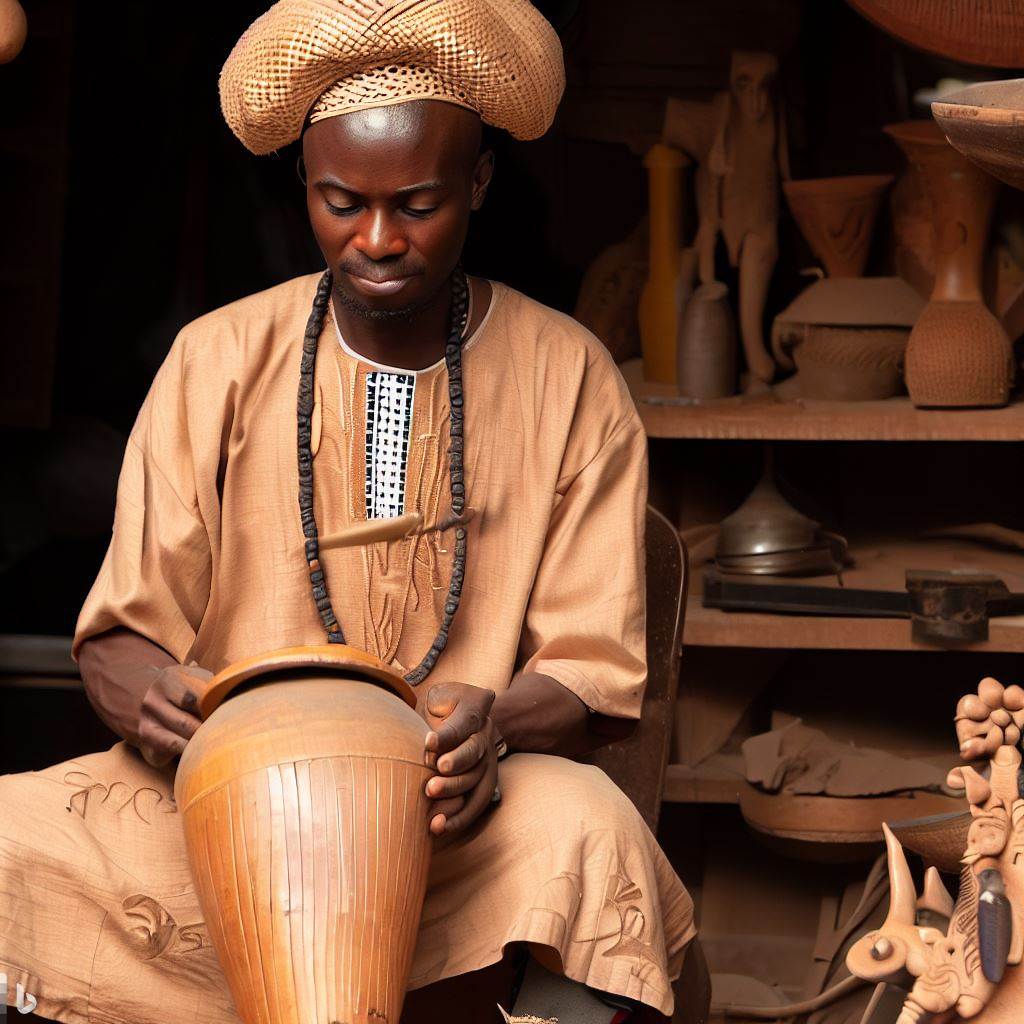Introduction
Craftsmanship, the art of creating fine and unique items by hand, has a long history in Nigeria.
Tourism, on the other hand, plays a crucial role in the country’s economy, creating jobs and attracting foreign exchange.
It’s no wonder that craftsmanship has become a driver of tourism in Nigeria.
Craftsmanship represents Nigeria’s rich cultural heritage. It is a showcase of the country’s diverse art, textiles, pottery, beadwork, and carving industries.
The exquisite work of Nigerian craftsmen is now available for tourists to experience and enjoy.
Tourism in Nigeria plays an important role in the nation’s economic growth.
Amazing wildlife, historical landmarks, beautiful beaches, and cultural festivals are just a few examples of the attractions that draw tourists to Nigeria.
The Nigerian government has placed a strong emphasis on developing the tourism industry and promoting the country’s natural and cultural resources.
Craftsmanship is considered a cornerstone of Nigeria’s tourism industry, contributing significantly to the growth of local economies.
Tourists are drawn to the uniqueness of handmade products, and many artisan communities have become popular tourist destinations.
These communities often offer interactive experiences that allow tourists to learn more about the crafts and techniques used by Nigerian artisans.
In essence, craftsmanship is a vital component of Nigeria’s tourism industry. Its unique and richly cultural heritage continues to attract tourists from all over the world, contributing to the country’s economic prosperity.
Nigeria’s diverse crafts have helped create communities of skilled artisans, who are now recognized globally.
The promotion and development of Nigeria’s rich cultural heritage through craftsmanship is key to the country’s future tourism success.
Craftsmanship in Nigeria
Craftsmanship is an essential part of the Nigerian culture, with a rich history and diverse types of crafts. From pottery to basket weaving, craftsmanship has been a way of life for Nigerians for centuries.
In this blog section, we will take a closer look at the history of craftsmanship in Nigeria, the various types of crafts, and the significance of crafts in Nigerian culture.
Brief History of Craftsmanship in Nigeria:
Craftsmanship has been a part of the Nigerian culture for as long as historians can remember.
The earliest recorded evidence of craftsmanship in Nigeria dates back to the Nok culture (500 BC-200 AD), which is known for its distinctive terra-cotta sculptures.
The Benin Empire (1440-1897) also played a significant role in the development of Nigerian craftsmanship with its ivory carving and bronze casting.
During the colonial era, Nigeria’s crafts industry suffered a decline due to the introduction of foreign goods. However, after Nigeria gained independence in 1960, there was a renewed interest in promoting Nigerian crafts.
Various Types of Crafts in Nigeria:
Nigeria is home to a diverse range of craftsmen, each practicing a particular type of craft.
Some of the most popular types of crafts in Nigeria include pottery, weaving, woodcarving, beadwork, leatherwork, metalwork, and embroidery.
Pottery is a craft that has been practiced in Nigeria for thousands of years, with each region producing distinctive styles.
Weaving, on the other hand, is one of the oldest crafts in Nigeria, with basket weaving being a common practice.
Woodcarving is another popular craft, with artisans producing intricate sculptures, masks, and furniture.
Beadwork is a craft that has been around since ancient times and is used to adorn clothing and accessories. Leatherwork is a craft that is used to produce bags, shoes, belts, and other accessories.
Metalwork is a relatively new craft in Nigeria, but it has gained popularity, with artisans producing jewelry, sculptures, and other decorative items.
Embroidery is also a popular craft, used to decorate clothing, accessories, and home décor.
Significance of Crafts in Nigerian Culture
- Crafts are an essential part of Nigerian culture, with each craft having cultural significance.
- Crafts tell stories, celebrate milestones, and mark occasions in Nigeria.
- Pottery stores food, representing different tribes and regions.
- Weaving produces clothing, mats, and baskets.
- Woodcarving creates sculptures and masks for ceremonies and festivals.
- Beadwork signifies status, using patterns and colors for specific occasions.
- Leatherwork makes bags, shoes, and belts for Nigerian fashion.
- Metalwork produces jewelry and decorative items often used as gifts.
In summary, craftsmanship has played a significant role in Nigeria’s history and culture.
From the Nok culture to the present day, Nigerian craftsmen have produced distinctive and intricate works of art.
The various types of crafts in Nigeria have cultural significance and are often used to tell stories and mark important occasions.
As Nigeria continues to promote its tourism industry, craftsmanship is emerging as a significant driver of tourism.
Travelers seeking an authentic Nigerian experience can visit local craft markets, watch craftsmen at work, and purchase unique and beautiful handmade items to take home.
Read: The Role of Government in Promoting Trade Skills
The Impact of Craftsmanship on Tourism
Craftsmanship has played an essential role in the growth of tourism in Nigeria.
The country boasts of a rich cultural heritage that is reflected in the artistic prowess of its craftsmen. This section discusses the impact of craftsmanship on tourism in Nigeria.
Attracting Tourists to Nigeria through Crafts
Crafts are an essential attraction that can lure tourists to Nigeria. Local craftsmen produce a rich collection of cultural artifacts, including sculptures, pottery, and textiles.
Tourists fascinated by Nigeria’s culture and art are drawn to these handmade products. The Nigerian government has recognized the enormous potential of crafts in attracting tourists to the country.
It has, therefore, made efforts to support and promote the craftsmanship industry. Some of these efforts include training programs, funding, and incentives for craftsmen.
This support has resulted in increased production and availability of handmade products, which has boosted the tourism industry.
The Role of Crafts in Cultural Tourism
Crafts are an essential component of cultural tourism. Tourists who visit Nigeria are intrigued by the cultural artifacts produced by local craftsmen.
These artifacts are a reflection of the cultural heritage of the Nigerian people. By purchasing these handmade products, tourists experience and appreciate the culture of the country.
These experiences create a bond between the tourists and the Nigerian people, which could lead to repeat visits, referrals, and positive reviews of Nigeria as a tourism destination.
The Nigerian government and private sector players have recognized the need to preserve and promote cultural heritage.
They have initiated programs to build museums and galleries to showcase artworks produced by craftsmen.
These platforms promote cultural tourism by providing an opportunity for tourists to interact with the artworks and learn about the culture from the artists themselves.
Showcase of Craftsmanship as a Tourism Product
Craftsmanship has become a tourism product in Nigeria. Tourists visiting Nigeria witness craftsmen producing artifacts in different regions of the country.
Craft centers organize tours, allowing tourists to experience the handmade product production processes.
These tours offer a unique experience for tourists to appreciate and learn about the culture of Nigeria.
Nigeria has utilized various platforms to showcase its craftsmanship. The country has participated in various international exhibitions, trade fairs, and cultural events to show the world the creativity and artistry of its craftsmen.
These platforms have exposed Nigeria to a broader market, resulting in increased demand for Nigerian handmade products. Craftsmanship has played a pivotal role in the growth of tourism in Nigeria.
The artistic prowess of Nigerian craftsmen has not only attracted tourists to the country but also provided them with unique experiences that have created a bond between tourists and the Nigerian people.
The Nigerian government and private sector players have recognized the enormous potential of crafts for tourism and initiated programs to preserve and promote cultural heritage.
By showcasing craftsmanship as a tourism product, Nigeria has built a positive reputation as a tourism destination, which has resulted in increased revenue for the country.
Read: Case Study: Successful Craft Businesses in Nigeria

The Challenges of Revitalizing Craftsmanship in Nigeria
Despite the potential of craftsmanship to drive tourism in Nigeria, there are several challenges that hinder the growth and development of the industry. Some of these challenges include:
Low level of investment in craftsmanship
One major challenge facing the craftsmanship industry in Nigeria is the low level of investment in the sector.
Most craftsmen in Nigeria operate on a small scale and lack the necessary funds to grow and upscale their businesses.
This lack of investment hinders their ability to improve the quality of their products, increase their production capacity, and effectively market their products to potential buyers.
Lack of infrastructure to support craftsmanship
- The lack of infrastructure is a major challenge for the Nigerian craftsmanship industry.
- Craftsmen in remote areas face difficulties transporting products due to poor transportation networks.
- The absence of storage facilities limits their ability to store products for extended periods.
This lack of infrastructure hinders access to raw materials and necessary equipment for production.
Brain drain and lack of skilled craftsmen
The craftsmanship industry in Nigeria is also facing a challenge of brain drain and a lack of skilled craftsmen.
Many young Nigerians are not interested in learning craftsmanship skills, as they see the industry as outdated and unattractive.
This lack of interest has led to a shortage of skilled craftsmen in the country, which hinders the production capacity of the industry.
Additionally, many skilled craftsmen are leaving Nigeria in search of better opportunities abroad, further depleting the industry’s skilled workforce.
The government must provide a conducive environment by investing in infrastructure, funding, and supportive policies.
The private sector plays a crucial role by investing, providing technical assistance, and marketing products.
Craftsmen should upscale businesses by investing in quality materials, improving production processes, and embracing technology.
Collaboration in cooperatives helps access finance, raw materials, and marketing information.
Addressing these challenges allows the craftsmanship industry to drive tourism and contribute to economic growth in Nigeria.
Read: The Global Influence of Nigerian Craftsmanship
The Way Forward
As noted in the previous sections, craftsmanship can play a critical role in driving tourism in Nigeria. However, to fully realize this potential, several steps need to be taken:
- Collaborations between craftspeople and tourism operators: A close working relationship between these two groups can help to promote and market local crafts to tourists effectively. Tourism operators can also provide valuable insights into the needs and preferences of tourists, helping craftspeople to tailor their products accordingly.
- Training and education of craftsmen: Many Nigerian craftsmen have limited access to formal training and education. Providing them with the necessary skills and knowledge can help them to produce high-quality, marketable goods and improve their livelihoods. This training should cover not only technical skills but also business management, marketing, and sales.
- Development of craft villages and centres: Establishing craft villages and centres can create a conducive environment for craftspeople to showcase and sell their wares. These centres can also serve as tourist attractions in their own right, providing visitors with the opportunity to interact with craftsmen and experience the creative process first-hand.
In addition to these broad measures, there are several other specific steps that can be taken to promote craftsmanship as a driver of tourism in Nigeria
- Promotion of local crafts through social media: Social media platforms such as Facebook, Instagram, and Twitter provide craftsmen with a cost-effective way to market their products and reach a wider audience. Tourism operators can also use these platforms to showcase the unique crafts and cultural experiences available in Nigeria.
- Incorporation of local crafts into hotel décor: Hotels and resorts can play a significant role in promoting local crafts by incorporating them into their décor. This can help to expose tourists to Nigerian craft traditions and create a market for locally produced goods.
- Establishment of craft fairs and exhibitions: Regularly scheduled craft fairs and exhibitions can help to raise the profile of Nigerian crafts and provide craftsmen with an opportunity to sell their products directly to consumers.
- Support for traditional crafts: Many traditional craft forms are at risk of dying out due to a lack of demand and interest. Supporting traditional craftsmen through initiatives such as microfinance loans, apprenticeships, and marketing assistance can help to preserve these cultural treasures for future generations.
Additinally, there is enormous potential for craftsmanship to drive tourism in Nigeria.
Craftspeople, tourism operators, and policymakers can work together to unlock potential and create sustainable economic development nationwide.
Read: The Crafts of Nigeria: Celebrating Diversity and Talent
Discover More: Craftsmanship: The Backbone of Nigeria’s Cultural Heritage
Conclusion
Nigerian craftsmanship showcases cultural heritage, creates jobs, and boosts the economy.
Investing in and promoting it attracts tourists to purchase handmade products and experience traditional techniques.
We must recognize the importance of preserving Nigerian craftsmanship and encourage its growth both locally and globally.
It is crucial that we continue to celebrate and support the generations of artisans who have maintained their craftsmanship traditions with respect, pride, and skill.
In summary, ours is a call to action to everyone to invest in and promote Nigerian craftsmanship. Together, we can work towards promoting Nigeria as a global hub for handmade products and sustainable tourism in Africa.





I love this works as an artist. Thanks for contributing to knowledge, in this discipline.
Thank you very much for your feedback.